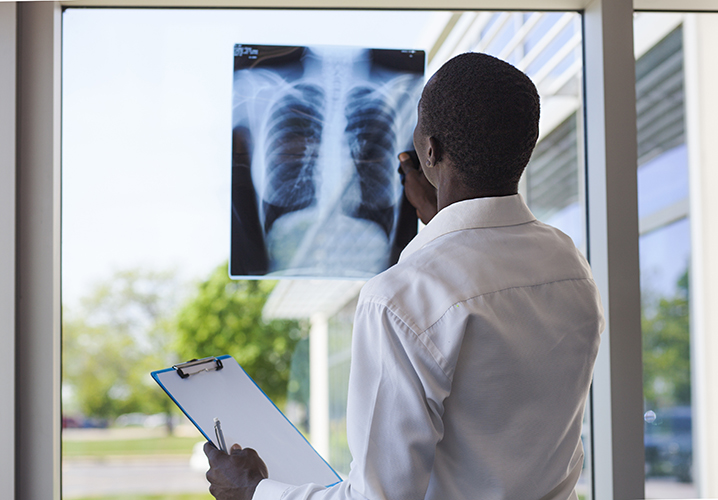WHAT ARE LUNG NODULES?
A lung nodule is a small mass of tissue in the lung often referred to as a “spot on the lung” or a “shadow” when seen on an X-ray or CT Scan. Round or oval in shape, a lung nodule can be an incidental finding during a normal/routine chest x-ray. There are two main types of lung nodules: benign and malignant. Pulmonary nodules are smaller than 3 cm (or 1.2 inches). If the lesion is measured to be larger than 3 cm, it becomes known as a lung or pulmonary mass. Most lung nodules are benign; however, the larger growths are more likely to be malignant.

CAUSES OF BENIGN LUNG NODULES
There can be many different causes of lung nodules, but most are the result of inflammation in the lung due to a previous infection or a progressive disease process.
Common causes of noncancerous lung nodules include:
- Infections – a wide range of infections from bacterial to fungal can often form a small collection of cells known as a granuloma. Granulomas are formed when the immune system isolates a foreign body. Granulomas are small areas of inflammation that can calcify over time.
- Non Infectious diseases such as rheumatoid arthritis and sarcoidosis can produce benign lung nodules
- Neoplasms are abnormal growths that can be either benign or malignant.
Non cancerous neoplasms:
Malignant neoplasms:
RISK FACTORS FOR MALIGNANT LUNG NODULES
The risk factors for cancer increases when:
DIAGNOSING AND TREATING LUNG NODULES
If you have been diagnosed with a lung nodule that is less than 2 cm, and you do not have any risk factors, your physician will most likely keep an eye on it. This may include more routine x-rays or CT scans to determine if the nodule is stable and not growing or changing. Benign lung nodules grow very slowly and some do not grow or change shape over time.
For all cancers and especially lung cancers, early detection and proper treatment is the key to successful health outcomes and increased life expectancy. If you have been diagnosed with a lung nodule and have risk factors associated with lung cancer, your physician or pulmonologist will offer additional testing such as: CT scan, PET (positron emission tomography) scan, blood tests, pulmonary function studies, or a minimally invasive lung biopsy to remove a small amount of tissue for pathological analysis.
HOW LUNG HEALTH SERVICES CAN HELP
Lung Health Services physicians are highly trained and experienced interventional pulmonologists delivering advanced, minimally invasive diagnostic and treatment techniques. The most common tool used to diagnose and analyze tissue from a lung nodule is a bronchoscopy. The bronchoscopy procedure is a sophisticated technology that utilizes a flexible tube with a camera at the end allowing visualization of the inside of the lungs and airways and the capability to sample tissue if needed.
First Visit
Your first visit begins with a phone call. After we take your information, we will collect the necessary records required to make a full plan of care from diagnosis to most effective treatment options.
Our first visit with you will encompass a full diagnostic evaluation to include:
- Interview, intake, full history and physical
- Lung functions are measured in person or with virtual spirometry techniques
- Review all imaging and radiological studies
- Full plan of care is developed the same day with goals to achieve the earliest, most effective therapy to support lung health specifically and the body as a whole
As interventional pulmonologists, we welcome your general doctor or pulmonologist to join any phone calls or virtual meetings. We believe when we work collaboratively to care for our patients, we can generate the best possible health outcomes.
Take the next step today – call Lung Health Services at (267) 500-5027.

